Imposter Lobster
Thursday, October 8, 2006On our first morning in Maine we found the following headline blazed across the front page of the local newspaper: Imposter Lobster. Not a headline designed to instill confidence in our stated intention of devouring our fair share of lobster while we were here. According to the article, Maine Senator Olympia Snowe had written the FDA, urging a prohibition on claiming lobster as an ingredient unless it was the real thing. Apparently, a lot of what is passed off as lobster in restaurant chains is actually meat from the langostino lobster, which is really a crab. Of course, most of what is passed off as crab is something else, so go figure ;-(
We came to Maine to eat boiled lobster. Not rolled, bisqued, chowdered, souffled, fried, barbequed, caked, tacoed, pancaked, ice creamed, or whatever other lobster permutation human ingenuity can come up with. We wanted real, live, staring us balefully in the eye when we pick it out of the tank, Maine Lobster.
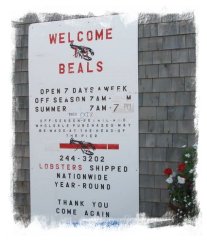 According to our infallible guidebook, Hidden New England, Beals in Southwest Harbor was the place to go. So we did.
According to our infallible guidebook, Hidden New England, Beals in Southwest Harbor was the place to go. So we did.The lobster pound is a dying institution in Maine. A lobster pound is exactly what it sounds like, a restaurant (sometimes no more than a shack on a pier) where you pick live lobster(s) out of a tank, specifying soft shell or hard, small lobster or large. You pay by the pound. Beals enjoys a good reputation – Southwest Harbor is on the back side of Mt. Desert Island, away from the crowds on the Bar Harbor/Acadia side. The sizable lobster boat fleet brings in their catch right by the restaurant, and Beals itself is so basic that you have to purchase drinks out of a coke machine outside on the pier. Anything other than lobster, clams, or seawater boiled corn must be ordered from another small food stand down the pier. The ‘dining’ room was a few wooden picnic tables sitting out front on the pier.
We loved it.
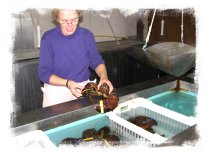 The staff managing the kitchen was French Canadian, and I could hardly understand a word they were saying. But it didn’t matter - in the tank were the largest, biggest, no make that the hugest lobsters any of us had ever seen – 2 ½ to 3 pound monsters. They looked big enough to fight back if given half a chance. To order, we pretty well just pointed at the tank with the big ones. The lobsters were picked up and heaved onto the scale (which sagged down alarmingly from the weight). I blanched for a minute thinking of the cost, but it turned out about what we’d normally pay for a typical lobster tail, but for probably 5 times the lobster meat.
The staff managing the kitchen was French Canadian, and I could hardly understand a word they were saying. But it didn’t matter - in the tank were the largest, biggest, no make that the hugest lobsters any of us had ever seen – 2 ½ to 3 pound monsters. They looked big enough to fight back if given half a chance. To order, we pretty well just pointed at the tank with the big ones. The lobsters were picked up and heaved onto the scale (which sagged down alarmingly from the weight). I blanched for a minute thinking of the cost, but it turned out about what we’d normally pay for a typical lobster tail, but for probably 5 times the lobster meat.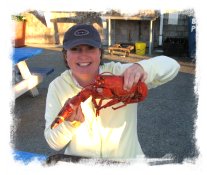 We got the soft shell lobster, and after a few minutes waiting for them to be boiled, we launched into digging through the monsters. It was delicious (and corn boiled in seawater is a new favorite of ours!) Undoubtedly the knowledge that we had more than a couple of bites of lobster in front of us led to some of our pleasure, but it was undeniably wonderful.
We got the soft shell lobster, and after a few minutes waiting for them to be boiled, we launched into digging through the monsters. It was delicious (and corn boiled in seawater is a new favorite of ours!) Undoubtedly the knowledge that we had more than a couple of bites of lobster in front of us led to some of our pleasure, but it was undeniably wonderful.About halfway through a gentleman walks up, takes one look at the size of our lobsters, then immediately goes and orders him one. We started talking, and turns out he had already eaten that evening, but wanted more lobster. He was staying on the other side of the harbor, and his hotel hosts told him Beals was ‘where the lobster boats come in’. So for his second dinner of the evening, he joined us in feasting on another lobster that must have been irradiated sometime early in life to grow so big.
Ah….I still smile to think of it. Denise and I both decided the only thing that could make it better would be to next time forgo the clams, and instead order one more lobster to split between us.
Thus we fell prey to one of the seven deadly sins – gluttony, and it nearly did us in. Several evenings later after a wonderful sailing trip around Southwest Harbor, we decided to have lobster one last time– (Beals closed at 7pm that night for the season). The staff spoke English this time, which surprisingly made ordering quite a bit more difficult. It was like ordering at Starbucks, with too many permutations of lobster to understand and select from.
It was much easier grunting and pointing in French ;-)
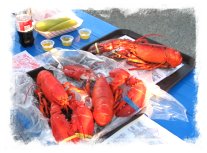 Finally, falling prey to our baser instincts, we picked out the three largest lobsters in the tank (hardshell this time, which have more meat), and settled back awaiting our season ending feast.
Finally, falling prey to our baser instincts, we picked out the three largest lobsters in the tank (hardshell this time, which have more meat), and settled back awaiting our season ending feast.Groan. Too much of any good thing is well, too much, and this was no exception. Denise barely made it through her lobster, and I could have easily thrown in the towel after mine. However, after just having shelled out some real bucks for the remaining giant, I was bound and determined to finish it off properly, paying due homage for its sacrifice. The only other option was to take it back to the camper, and I didn’t relish the thought of cleaning up the mess it would make back at our rolling home on wheels.
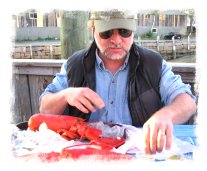 Lobster at one point was considered a trash fish, only good for feeding the servants and members of the underclass. At one point several New England legislatures passed laws restricting how often lobster could be served to prisoners, as too much was considered cruel and unusual punishment! We laughed at the time when we heard about this, but mid-way thru that second 3 lb lobster I came to sympathize with the prisoners! No longer was I digging under the legs to find the last tasty morsels. Instead, I was wondering if I was going to make it past the second claw, much less the tail. What tasted like a delicacy just a few mins before, now tasted like slimy rubber. Pride, another deadly sin, made its appearance, demanding that I finish the beast. So I did, just barely ahead of the point where it finished me instead.
Lobster at one point was considered a trash fish, only good for feeding the servants and members of the underclass. At one point several New England legislatures passed laws restricting how often lobster could be served to prisoners, as too much was considered cruel and unusual punishment! We laughed at the time when we heard about this, but mid-way thru that second 3 lb lobster I came to sympathize with the prisoners! No longer was I digging under the legs to find the last tasty morsels. Instead, I was wondering if I was going to make it past the second claw, much less the tail. What tasted like a delicacy just a few mins before, now tasted like slimy rubber. Pride, another deadly sin, made its appearance, demanding that I finish the beast. So I did, just barely ahead of the point where it finished me instead.Let us just say I got my fill of lobster for awhile.
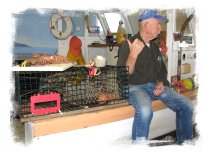 Maine has the most coastal islands of any state, and this creates a shoreline with a zillion tiny harbors. It seems that all of them are full of lobster boats. It’s a hard life, and the economics are borderline for the fishermen. A licensed lobster boat can have up to 800 traps, and these need to be located, hauled up off the bottom, checked for lobster, and baited every couple of days. There are size restrictions on lobster (smaller than 3 inches and larger than 5 across the back must be thrown back), and pregnant females have a notch cut in their tail to indicate a successful breeder, and are also returned. Any previously notched lobsters must also be thrown. These steps are taken to ensure a self sustaining level of lobsters in Maine waters. Lobstermen are notoriously protective of their ‘territories’, and newcomers or outsiders will often find their buoys cut away from their traps. This has the effect of making it nearly impossible to locate the lobster traps without diving, a very expensive process.
Maine has the most coastal islands of any state, and this creates a shoreline with a zillion tiny harbors. It seems that all of them are full of lobster boats. It’s a hard life, and the economics are borderline for the fishermen. A licensed lobster boat can have up to 800 traps, and these need to be located, hauled up off the bottom, checked for lobster, and baited every couple of days. There are size restrictions on lobster (smaller than 3 inches and larger than 5 across the back must be thrown back), and pregnant females have a notch cut in their tail to indicate a successful breeder, and are also returned. Any previously notched lobsters must also be thrown. These steps are taken to ensure a self sustaining level of lobsters in Maine waters. Lobstermen are notoriously protective of their ‘territories’, and newcomers or outsiders will often find their buoys cut away from their traps. This has the effect of making it nearly impossible to locate the lobster traps without diving, a very expensive process.Reeling from my lobster overdose, I also picked up a cold that Denise had been fighting for a few days. Therefore I was laid up when Denise and Vance went to the Bar Harbor Oceanarium. There they learned how lobsters breed, and the difficulties raising them in a controlled environment. Also on view was a rare Blue Lobster - only one in a million have blue coloring.
Back in Georgia, Miles' (Vance's older brother) only request for our entire trip was that we ship him some lobster from Maine. Forget the T-shirts and the tacky fridge magnets. A couple of days later he received 4 live lobsters airfreighted from Beals......they ship year round. By all accounts the lobsters were well received by Miles and his buddies.

Vance: The Oceanarium was very fun. They had a museum, lobster hatchery, and a nature hike that can only be walked during a program. First Mom and I went into the museum and saw some articles and some very unique lobsters. One lobster was a bicolor of black and red. The other lobster was a blue lobster…very rare.
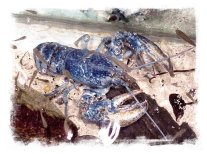 Then we went into the hatchery and saw the stages of the baby lobsters. Baby lobsters have to be separated from each other or they will bite each other. A female lobster can have up to 3000 eggs under her tail. Next we went on the nature hike and learned about a lot of animals. The owner’s sheep were running and eating all the grass they could. Later we saw a kind of fish called a Mummy fish. In a canopy there was a exhibit of a Great Blue Herron that was hit by a car.
Then we went into the hatchery and saw the stages of the baby lobsters. Baby lobsters have to be separated from each other or they will bite each other. A female lobster can have up to 3000 eggs under her tail. Next we went on the nature hike and learned about a lot of animals. The owner’s sheep were running and eating all the grass they could. Later we saw a kind of fish called a Mummy fish. In a canopy there was a exhibit of a Great Blue Herron that was hit by a car.WHAT DO LOBSTERS HAVE TO DO WITH HISTORY!
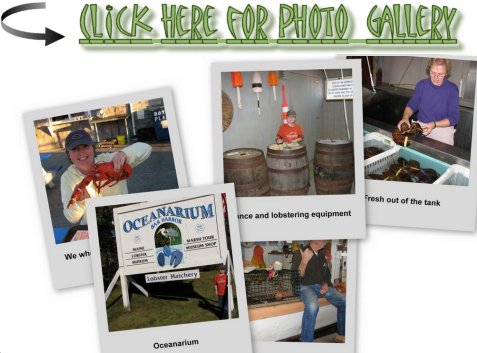







<< Home